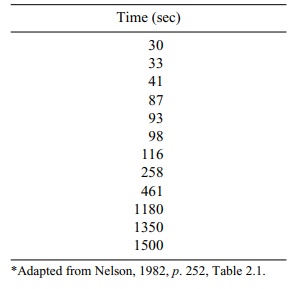Goodness of Fit Tests-Fitting Hypothesized Probability Distributions
| Home | | Advanced Mathematics |Chapter: Biostatistics for the Health Sciences: Categorical Data and Chi-Square Tests
Goodness of fit tests are tests that compare a parametric distribution to observed data.
GOODNESS OF FIT TESTS-FITTING HYPOTHESIZED PROBABILITY DISTRIBUTIONS
Goodness of fit tests are tests that compare a
parametric distribution to observed data. Tests such as the Kolmogorov–Smirnov
test look at how far a parametric cumulative distribution (e.g., normal or
negative exponential) deviates from the em-pirical distribution. There is a
chi-square test for goodness of fit. Recall the negative exponential
distribution is a distribution with the probability density f(x)
= λ exp(–λx) for x
> 0, where λ > 0 is known as the rate parameter.
For the chi-square test, we divide the range of
possible values for a random vari-able into connected disjoint intervals. By
this we mean that if the random variable can only take on values in the
interval [0, 10] then the set of disjoint connected in-tervals could be [0, 2),
[2, 4), [4, 6), [6, 8), and [8, 10]. These intervals are disjoint because they
contain no points in common. They are connected because there are no points
missing in between the intervals and when they are put together they com-prise the
entire range of possible values for the random variable.
For each interval, we count the number (or
proportion) of observations from the observed data that fall in that interval.
We also compute an expected number for the fitted probability distribution. The
fitted probability distribution is simply the para-metric distribution that
uses estimates for the parameters in place of the unknown parameters. For
example, a fitted normal distribution would use the sample mean and sample
variance in place of the parameters μ and σ2, respectively. As with the other chi-square tests
described in this chapter, we compute the quantities (Oi – Ei)2/Ei for each interval i and sum them up over all the intervals
i = 1, 2, . . . , k. Here Ei is obtained by integrating the fitted probability
density function over the ith interval.
Under the null hypothesis that the data come from
the parametric distribution, the test statistic has an approximate chi-square
distribution with k – q – 1 degrees of freedom, where q is the number of parameters estimated
from the data to compute the expected values Ei.
So for a normal distribution, we would need to
estimate the mean and standard deviation. Consequently, q would be 2 and the degrees of freedom would be k – 3. For a negative exponential
distribution, we need to estimate only the rate parameter, so q = 1 and the degrees of freedom are k – 2. Recall that the rate parameter
mea-sures how many events we expect per unit time. Generally, we do not know
its val-ue a priori but can estimate it after the data have been collected. For
a detailed ac-count of goodness of fit tests for both continuous and discrete
random variables, see the Encyclopedia of
Statistical Sciences, Volume 3 (1983), pp. 451–461.
The following example, taken from Nelson (1982),
represents complete lifetime data for a negative exponential model. The table
presents the time to breakdown of insulating fluid at a voltage of 35 kV. In
this case, we have 12 observed times, which are shown in Table 11.14.
TABLE 11.14. Seconds to Insulating Fluid Breakdown at 35 kV*

First, we need to estimate the rate parameter. The
best estimate of expected time to failure is the sum of the failure times
divided by the number of failures. This esti-mate is often referred to as the
mean time between failures. Using the data in Table 11.14, we calculate the
mean time between failures as follows:
(30 + 33 + 41 + 87 + 93 + 98 + 116 + 258 + 461 +
1180 + 1350 + 1500)/12 = 437.25 seconds
The reciprocal of this quantity is called the
failure rate. In our example, it is 0.002287 failures per second.
Now we can determine for any interval the
probability of failure in the interval denoted pi for interval i.
Since S(t) = exp(–λt) is the survival probability for the interval [0, t], we can estimate λ as 0.002287. For any interval, i
= [ai, bi], and pi, the probability of failure in interval i, is estimated as exp(–0.002287ai) – exp(–0.00287bi).
Suppose we have a range of values [0,∞]. Now let us divide [0,∞] into four dis-joint intervals:
[0, 90], [90, 180], [180, 500], and [500,∞]. We
observe four failures in the first interval, two failures in the second
interval, two failures in the third in-terval, and three in the last interval.
For each i, Ei = npi. The resulting
computations for this case, where n =
12, are given in Table 11.15.
In this example, the chi-square statistic is 2.13.
We refer to the chi-square table (Appendix D) for the distribution under the
null hypothesis. Since k = 4 and q = 1, the degrees of freedom are k – q
– 1 = 2. From Appendix D we see that the p-value
is between 0.10 and 0.90. So we cannot reject the null hypothesis of a negative
exponential distribution. The data seem to fit the negative exponential distribution
reasonably well.
Related Topics
